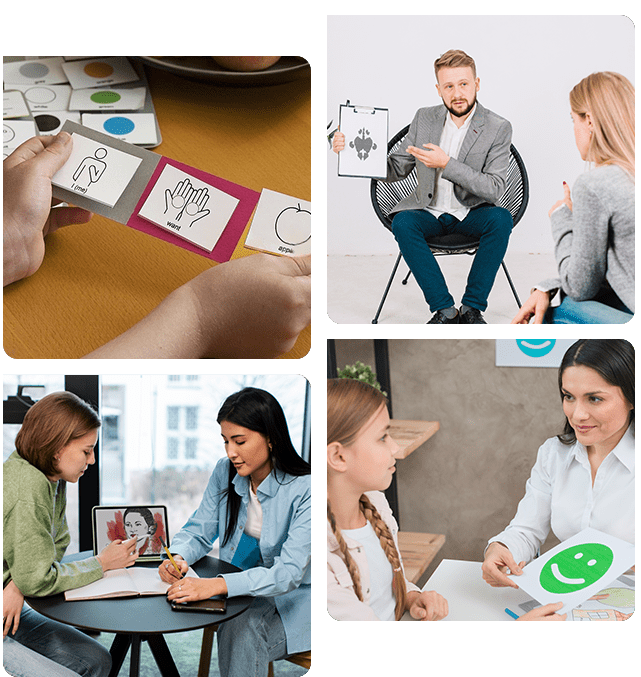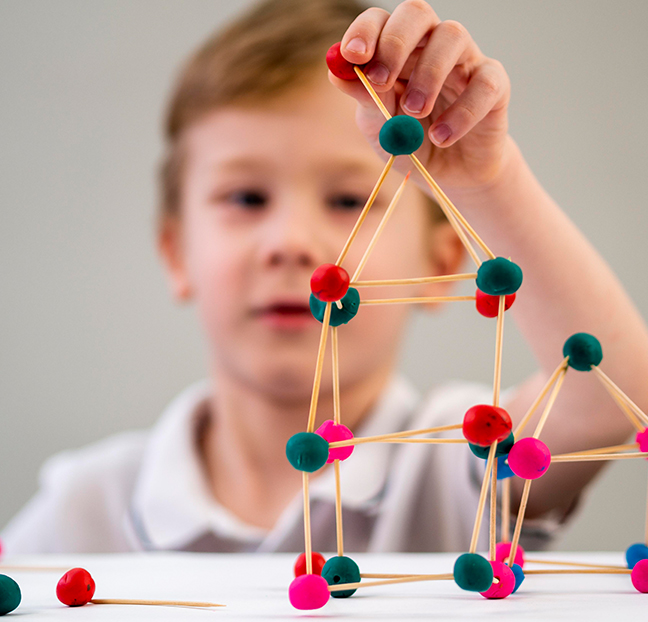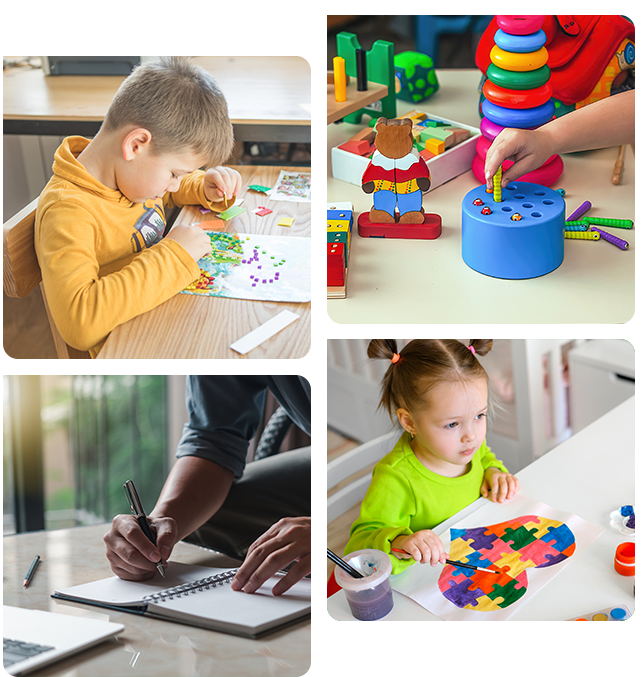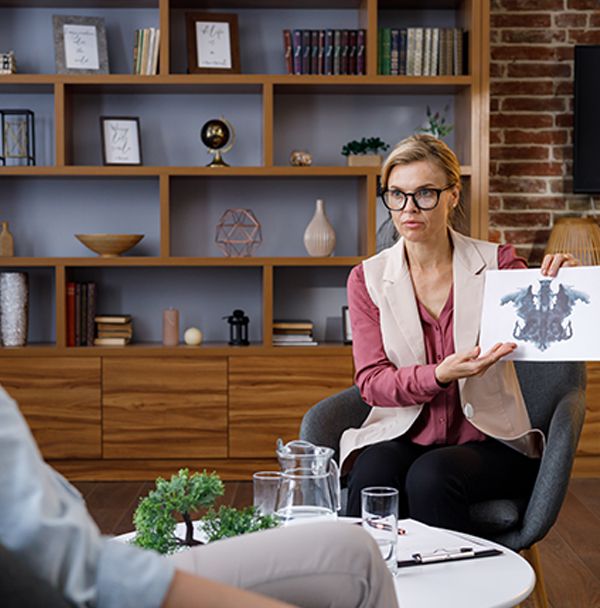
Picture Exchange Communication System in Karachi
Book An Appointment For Intake Session / Consultancy / OPD charges Rs. 1000/- only
Connect With Us For The Consultancy
Through pictures, words become bridges that connect hearts and minds, empowering communication to flourish."
What is PECS?
PECS, or Picture Exchange Communication approach, is an evidence-based alternative communication approach designed to help people who have trouble functioning in social contexts improve their communication abilities. It uses pictures or visual symbols to engage participants in an innovative approach that allows them to readily communicate their requirements.
PECS is based on the idea that individuals with communication challenges can effectively communicate through pictures by exchanging them with a communication partner, typically a caregiver or teacher.

Inspire for Better Living…
Let’s Connect!
The Core Principles of PECS
PECS (Picture Exchange Communication System) key principles are fundamental rules that drive the successful placement of this alternative communication approach that increases its effectiveness. Every approach has a set of principles that serve as a foundation for persons who need this type of information to effectively communicate using pictures and symbols. Here are the key core principles of PECS:
How Does PECS Work?
Distance and Persistence
Teaching the individual to communicate with the partner even when they are at a distance. The individual learns to approach the partner, give them a picture card, and persist until the partner responds.
Responsive and Spontaneous
This stage involves training the user to utilise picture cards to respond to queries or remarks from communication partners. Additionally, they are encouraged to initiate communication spontaneously, sharing information or initiating social interactions.
The Benefits of PECS
Individuals gain from the Picture Exchange Communication System (PECS) in a variety of ways, including improved communication skills, which enhances their quality of life by creating positive social interactions.
Reduction in Frustration
For individuals who struggle with verbal communication, PECS offers an alternative means of expression, reducing frustration and challenging behaviors that may result from the inability to convey needs or desires effectively.
Encourages Independence
As individuals learn to communicate their needs using PECS, they gain a sense of autonomy and independence. Individuals with this newly acquired skill to initiate discussion can make decisions, request support, and participate more actively in many aspects of daily life.
Sentence Structure
Using sentence starter strips and picture cards, the individual learns to form simple sentences. This helps children to express more than just single-word requests.
Use of Speech
The final phase aims to transition the individual from using only picture cards to incorporating verbal language alongside the pictures. The strategy promotes the development of speech and communication abilities, as well as the use of PECS where appropriate.
Improved Communication Skills
PECS provides a structured and effective way for individuals to express their needs, wants, and feelings through pictures or visual symbols. Individuals learn key communication skills as they go through the PECS phases, leading to enhanced expressive and receptive language ability.
Enhanced Social Interactions
By enabling individuals to initiate communication with others using picture cards, PECS promotes engagement in social interactions. Individuals are encouraged to communicate with classmates, carers, and teachers in a more secure manner, resulting in true connections and the removal of social isolation.
Generalization of Skills
One of the notable benefits of PECS is that the communication skills acquired in structured settings can often be generalized to various environments. Individuals can use their PECS communication abilities in a many settings, including at home, school, and in the community.
Picture Exchange Communication System in Karachi
Book An Appointment For Intake Session / Consultancy / OPD charges Rs. 1000/- only
Connect With Us For The Consultancy

Integrating ABA Principles in PECS.
Most important techniques of Applied Behavior Analysis (ABA) commonly utilized in PECS (Picture Exchange Communication System):
Task Analysis:
ABA breaks down complex skills into smaller, manageable steps. Task analysis in PECS assists in identifying an individual's present communication abilities and determining the proper beginning point in the various phases of PECS implementation.
Prompting and Prompt Fading:
ABA uses prompting strategies to assist individuals in learning new skills. In the context of PECS, prompts may be provided to guide the individual in selecting and exchanging picture cards. As the individual becomes more proficient, prompts are systematically faded to promote independent communication
Reinforcement:
Positive reinforcement is a core principle of ABA and is integrated into PECS to motivate and encourage communication attempts. When the individual initiates communication using picture cards, they receive immediate reinforcement, such as access to the requested item or activity or positive praise.
Data Collection and Analysis:
ABA emphasizes data collection to monitor progress and make data-driven decisions. In PECS, data is collected on the individual's use of picture cards, the effectiveness of communication attempts, and the level of independence in using the system. This data guides adjustment in the intervention as needed.
Generalization and Maintenance:
ABA seeks to promote the generalization of skills across different settings and situations. In PECS, this involves ensuring that the individual can use picture communication during structured sessions and everyday environments. Additionally, maintenance is highly important as it will consistently sustain whatever skills that have been learned in this approach.
Empowered Communication by Experts
-
PECS (Picture Exchange Communication System) is facilitated by trained professionals.
-
Experts include speech-language pathologists, special education teachers, behavior analysts, and experienced caregivers.
-
Individuals with communication challenges learn to use picture cards to express their needs and desires.
-
Positive reinforcement and structured phases of PECS support skill development.
-
Empowered communication enhances social interactions and engagement with the environment.

Transformative Journeys at the Wellness Clinic: Elevate Your Life with TWC
We provide a variety of treatments at the Transformation and Wellness Clinic (TWC) that are designed to enhance and improve all aspects of your life.
Personalized Approach to Wellness:
At TWC, we understand that each individual's journey toward wellness is unique. Our knowledgeable staff takes a personalised approach, adjusting our services to your individual needs and objectives. We have the resources and skills to meet your needs, whether they are physical health, mental clarity, emotional healing, or a mix of these.
Holistic Health Solutions:
Embracing the concept of holistic health, TWC offers a wide range of services that encompass all aspects of well-being. From physical training and dietary counselling to mental health therapy and stress management tactics, we address the mind, body, and spirit to ensure complete and long-term results.
Expert Team of Specialists:
Our clinic is staffed with highly qualified and compassionate specialists who are leaders in their respective fields. Our staff consists of qualified trainers, licenced therapists, nutritionists, and wellness coaches who are all committed to giving the best possible therapy and support.
Empowering You for Life:
Beyond providing short-term solutions, TWC is committed to empowering you with the knowledge and tools necessary for lifelong well-being. After you leave the clinic, we will provide you with practical skills and processes to help you maintain a healthy, balanced lifestyle.
A Welcoming and Supportive Environment:
Our clinic has a welcoming ambiance that will make you feel at ease and supported during your trip. We believe that building a joyful and supportive environment is essential for substantial wellness breakthroughs.
At the Transformation and Wellness Clinic, we ensure that our clients get the best experience that leads them towards life of balance, vitality, and contentment. You will see the transformative power of wellbeing as you embark on this incredible adventure with TWC.
Picture Exchange Communication System in Karachi
Book An Appointment For Intake Session / Consultancy / OPD charges Rs. 1000/- only
Connect With Us For The Consultancy
PECS: Communication for Autism Spectrum Individuals.
-
It utilizes pictures and visual symbols to bridge the communication gap.
-
Individuals are taught to exchange picture cards to initiate interactions and express their needs.
-
PECS offers a structured and adaptable approach for various communication abilities.
-
PECS promotes social inclusion by minimising frustration and increasing involvement.
-
It fosters confidence, independence, and improved communication skills.
-
PECS benefits autistic individuals by focusing on improving their quality of life.
-
Use PECS to create a visual schedule for toilet training in autism. Reinforce each step with preferred items or activities. To support successful training, be consistent, use social stories, and satisfy sensory needs.

Enhancing Communication and Connection: PECS for Special Needs.
-
PECS is an effective communication method for special needs individuals.
-
It takes help from pictures and visual symbols to engage in communication and express their needs.
-
Individuals can initiate interactions and convey their desires by exchanging picture cards.
-
Because PECS is adaptive to different communication capacities, it is appropriate for an array of special needs individuals.
-
Implementing PECS can lead to reduced frustration, enhanced social interactions, and increased independence in daily life for those with special needs.
Communicating Without Verbal Clues: Expressing Your Needs Effectively.
-
Non-verbal communication is a powerful way to express needs when verbal language is challenging or unavailable.
-
Individuals can use body language, facial expressions, gestures, and eye contact to convey their desires and requirements effectively.
-
Using visual aids, such as pictures, symbols, or communication boards, can assist in conveying specific needs and preferences.
-
Active listening and observation are crucial for comprehending non-verbal cues and responding appropriately to the individual's needs.
-
Another type of strategy to help individuals with communication impairments such autism, speech disorders, or other developmental disabilities, is non-verbal communication.
Frequently Asked Questions (FAQ)
Picture Exchange Communication System in Karachi
Book An Appointment For Intake Session / Consultancy / OPD charges Rs. 1000/- only

